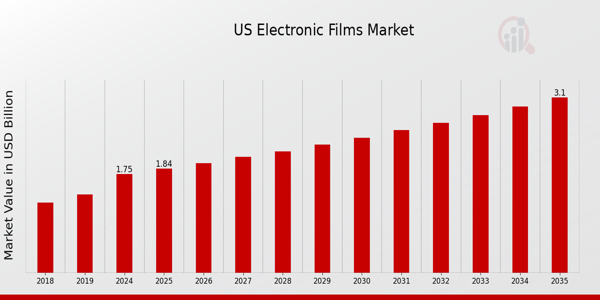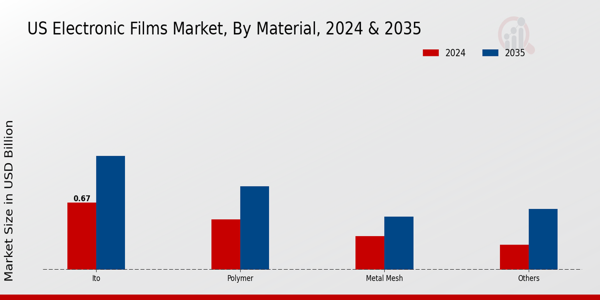US Electronic Films Market Overview:
As per MRFR analysis, the US Electronic Films Market Size was estimated at 1.43 (USD Billion) in 2023. The US Electronic Films Market Industry is expected to grow from 1.75(USD Billion) in 2024 to 3.1 (USD Billion) by 2035. The US Electronic Films Market CAGR (growth rate) is expected to be around 5.336% during the forecast period (2025 - 2035).
Key US Electronic Films Market Trends Highlighted
The US Electronic Films Market is experiencing several significant trends that are shaping its development. One key market driver is the increasing demand for advanced display technologies, such as OLED and LCD screens, which rely heavily on high-quality electronic films. The growth of the consumer electronics sector in the United States, driven by innovations in smartphones, tablets, and televisions, is fostering greater demand for electronic films that enhance display performance and energy efficiency. Moreover, the push for renewable energy solutions is driving opportunities in the production of solar cells, which require specific electronic films for improved efficiency. In recent times, the trend of miniaturization in electronic devices has also gained traction. As manufacturers focus on producing thinner and lighter designs, the requirement for specialized electronic films that can maintain high performance while reducing weight is becoming crucial. Additionally, the rise of electric vehicles (EVs) presents a new frontier for the electronic films market, as these vehicles increasingly integrate advanced display systems for user interfaces and controls. The US government's initiatives to support clean energy and technology innovation further bolster these trends, creating a favorable climate for investment and development in the electronic films sector. Furthermore, with the expansion of 5G networks, there is an opportunity to explore high-frequency applications that necessitate electronic films with superior quality and durability. The convergence of telecommunications and consumer devices creates additional avenues for market growth in electronic films, positioning the US as a key player in the global landscape. Overall, these trends point to a dynamic market environment characterized by innovation and new application possibilities.

Source: Primary Research, Secondary Research, MRFR Database and Analyst Review
US Electronic Films Market Drivers
Surge in Demand for Advanced Display Technologies
The US Electronic Films Market Industry is experiencing a significant increase in demand for advanced display technologies, particularly due to the growing popularity of OLED (Organic Light Emitting Diode) displays. According to the US Department of Commerce, the market for OLED has been growing at a rate of approximately 20% annually since 2020. This trend is primarily driven by the expansion of consumer electronics, including smartphones, televisions, and wearable devices.Major companies like Samsung Electronics and LG Display have invested heavily in Research and Development to improve OLED technology, thereby enhancing the quality and efficiency of displays. The increasing consumer preference for high-resolution screens is further accelerating the demand for electronic films, highlighting the growth potential within the US Electronic Films Market.
Growth in Renewable Energy Sector
The renewable energy sector, especially solar energy, is witnessing substantial growth in the United States, thereby impacting the US Electronic Films Market Industry positively. The U.S. Energy Information Administration reports that solar energy generation has doubled over the last five years, contributing to a greater need for efficient solar panels. Electronic films play a crucial role in improving the efficiency of photovoltaic cells. Companies such as First Solar are innovating in this space, impacting the demand for electronic films.Given that the solar industry is projected to create approximately 1.3 million jobs by 2030 according to the Solar Energy Industries Association, the momentum in this sector bodes well for the growth of electronic films in the US.
Increased Focus on Smart Packaging Solutions
The US Electronic Films Market Industry is being propelled by an increased focus on smart packaging solutions, particularly within the food and pharmaceuticals sectors. The Food and Drug Administration recognizes that smart packaging technologies can significantly enhance product safety and usability, a need that has been rising amid the pandemic. With nearly 72% of consumers considering packaging to be important when making purchase decisions, as noted by the Packaging Association, companies are incorporating electronic films that facilitate innovative packaging designs.This shift in consumer behavior is driving investments and developments in electronic films from organizations like Amcor and Sealed Air Corporation, thereby fostering market growth in the US.
US Electronic Films Market Segment Insights:
Electronic Films Market Material Insights
The Material segment of the US Electronic Films Market is crucial in defining the industry's landscape and fostering advancements in technology. The primary materials used, including Polymer, Indium Tin Oxide (ITO), Metal Mesh, and others, each play distinctive roles, contributing significantly to the overall functionality and market dynamics. Polymer materials are particularly valued for their flexibility, lightweight characteristics, and excellent electrical properties, making them indispensable in applications that require screen protection and enhanced device durability.ITO, known for its excellent transparency and electrical conductivity, serves as a pivotal component in display technologies, including touchscreens and solar cells, thereby maintaining high demand within the market. The Metal Mesh segment is gaining traction due to its ability to deliver multiple advantages such as improved conductivity, durability, and ease of fabrication, which is increasingly appealing for innovative applications in various electronic devices. Other materials in this segment also encompass diverse functions, catering to niche markets and advancing overall technological progress.Driven by trends such as the growing adoption of flexible displays, increased investment in Research and Development, and a rise in energy-efficient solutions, the Material segment is poised for substantial growth. Moreover, challenges such as material sourcing costs and regulatory compliance regarding environmental impact could influence market dynamics. The focus on sustainability and the development of alternative materials presents opportunities for innovation and growth in the Electronic Films Market as needs continue to evolve within the U.S.industry. Overall, the significance of the Material segment reflects its essential role in enhancing the performance and versatility of electronic devices, aligning with ongoing market trends and consumer demands.

Source: Primary Research, Secondary Research, MRFR Database and Analyst Review
Electronic Films Market Films Type Insights
The Films Type segment of the US Electronic Films Market encompasses various materials essential for advancing electronic applications. Polyethylene Terephthalate (PET) is widely utilized due to its excellent mechanical characteristics and optical clarity, making it a popular choice in flexible electronics and display technologies. Ethylene Tetrafluoroethylene (ETFE) stands out for its superior chemical resistance and electrical insulation properties, often used in high-performance applications involving solar panels and aerospace components. Perfluoroalkoxy (PFA) films provide exceptional flexibility and thermal stability, commonly employed in semiconductor manufacturing.Polytetrafluoroethylene (PTFE) is known for its non-stick and thermal resistance capabilities, making it significant in the production of a wide range of electronic devices. Thin Copper Films are increasingly popular for various applications, including circuit boards, due to their excellent electrical conductivity. Transparent Conductive Films (TCFs) are crucial for touch screens and displays, providing transparency and electrical conductivity. The demand for these specific films is driven by the increasing integration of electronics in various sectors, enabling significant innovation and efficiency in electronic applications across the US.The Electronic Films Market segmentation highlights these materials as vital for fostering advancements in technology and supporting the growing electronics industry.
Electronic Films Market Application Insights
The US Electronic Films Market focuses heavily on various applications, notably Electronic Display, Printed Circuit Boards (PCBs), Semiconductors, and other emerging uses. The Electronic Display segment is significant due to the increasing demand for high-definition screens in consumer electronics, automotive displays, and industrial applications, driving the need for advanced electronic films. Meanwhile, the PCB application plays a crucial role in the thriving electronics sector, where technological advancements necessitate reliable and efficient materials for circuit connectivity.The Semiconductor application remains vital as the push for smaller, faster, and more powerful devices continues, pushing manufacturers to seek innovative electronic films that enhance performance. Other applications are steadily emerging, reflecting the diversification of the electronics industry fueled by increasing automation and smart technologies. The overall growth in the US Electronic Films Market reflects trends such as miniaturization, a shift toward energy-efficient materials, and the rise of Internet of Things (IoT) devices, which collectively bolster the industry's expansion and adaptation to new challenges and opportunities.
US Electronic Films Market Key Players and Competitive Insights:
The US Electronic Films Market is characterized by a dynamic landscape where innovation and competition drive growth and opportunities. The market encompasses a wide range of products essential for electronic applications, including display technologies, photovoltaic systems, and flexible electronics. A combination of advanced manufacturing processes and cutting-edge materials plays a crucial role in defining competitive advantages among key players. The increasing demand for high-performance and energy-efficient electronic films has attracted various manufacturers, each striving to differentiate their offerings through superior technology, product quality, and strategic partnerships. Staying abreast of technological advancements and understanding shifts in consumer preferences are critical for companies looking to maintain their competitive edge in this rapidly evolving market.Nitto Denko operates within the US Electronic Films Market with a strong focus on innovation and quality, positioning itself as a key player. The company is renowned for its advanced adhesive films and optical films, which are widely used across various electronic applications, including displays and touchscreens. Nitto Denko's strengths lie in its robust R&D capabilities and a well-established supply chain, enabling it to deliver high-quality products tailored to meet the specific requirements of its customers. This commitment to excellence has allowed Nitto Denko to enhance its market presence in the US by providing reliable solutions that contribute to the functionality and efficiency of electronic devices, effectively solidifying its competitive position in the industry.Kodak offers a comprehensive range of products within the US Electronic Films Market, specializing in imaging and printing technologies that include film for image capture and electronic display. Kodak's strengths stem from its long history of innovation and expertise in developing advanced materials for electronic applications. The company has successfully leveraged its brand recognition and technical capabilities to maintain a strong foothold in the US market. Key product offerings include films for both traditional and digital photography, as well as solutions tailored for various electronic applications. Kodak has also engaged in strategic mergers and acquisitions, further expanding its product portfolio and market presence. Through a focus on addressing customer needs and adapting to technological advancements, Kodak continues to establish itself as a prominent competitor in the US Electronic Films Market, contributing to the evolution of the industry through innovative solutions.
Key Companies in the US Electronic Films Market Include:
Nitto Denko
Kodak
Toppan Printing
AgfaGevaert
Sumitomo Chemical
BASF
Henkel
Samsung Electronics
JX Nippon Oil and Energy
DuPont
Eastman Chemical Company
Fujifilm
LG Chem
3M
Merck Group
US Electronic Films Market Industry Developments
Recent developments in the US Electronic Films Market reveal significant progress and trends among key companies, including Nitto Denko, Kodak, Toppan Printing, AgfaGevaert, Sumitomo Chemical, BASF, Henkel, Samsung Electronics, JX Nippon Oil and Energy, DuPont, Eastman Chemical Company, Fujifilm, LG Chem, 3M, and Merck Group. In August 2023, Nitto Denko announced advancements in their production capabilities to cater to the rising demand for flexible electronics. Furthermore, mergers and acquisitions are impacting the market, notably in May 2023, when Fujifilm acquired a specialty inkjet technology firm to expand its offerings in high-performance materials. Growth in market valuation has been observed, particularly for companies like DuPont, which reported an increase in demand for its electronic films which is contributing positively to its market position. Over the past few years, key happenings include Kodak's strategic shift towards advanced films in March 2022, targeting the semiconductor industry, which reflects the broader trends towards specialization and innovation within the sector. Current affairs underscore the increasing focus on sustainable practices and materials, which are becoming critical factors for companies operating in the US Electronic Films Market.
US Electronic Films Market Segmentation Insights
Electronic Films Market Material Outlook
Polymer
ITO
Metal Mesh
others
Electronic Films Market Films Type Outlook
PET
ETFE
PFA
PTFE
TCFs
Copper Films
others
Electronic Films Market Application Outlook
Electronic Display
PCBs
Semiconductors
others
Report Scope:
| Report Attribute/Metric Source: |
Details |
| MARKET SIZE 2018 |
1.43(USD Billion) |
| MARKET SIZE 2024 |
1.75(USD Billion) |
| MARKET SIZE 2035 |
3.1(USD Billion) |
| COMPOUND ANNUAL GROWTH RATE (CAGR) |
5.336% (2025 - 2035) |
| REPORT COVERAGE |
Revenue Forecast, Competitive Landscape, Growth Factors, and Trends |
| BASE YEAR |
2024 |
| MARKET FORECAST PERIOD |
2025 - 2035 |
| HISTORICAL DATA |
2019 - 2024 |
| MARKET FORECAST UNITS |
USD Billion |
| KEY COMPANIES PROFILED |
Nitto Denko, Kodak, Toppan Printing, AgfaGevaert, Sumitomo Chemical, BASF, Henkel, Samsung Electronics, JX Nippon Oil and Energy, DuPont, Eastman Chemical Company, Fujifilm, LG Chem, 3M, Merck Group |
| SEGMENTS COVERED |
Material, Films Type, Application |
| KEY MARKET OPPORTUNITIES |
Emerging demand for flexible displays, Growth in solar photovoltaic applications, Advancements in OLED technology, Rise in electric vehicle components, Increased focus on sustainability and recyclability |
| KEY MARKET DYNAMICS |
Technological advancements, Growing consumer electronics demand, Increasing OLED applications, Rise in renewable energy solutions, Government regulations and standards |
| COUNTRIES COVERED |
US |
Frequently Asked Questions (FAQ) :
The US Electronic Films Market is expected to be valued at 1.75 billion USD in 2024.
By 2035, the projected market size for the US Electronic Films Market is expected to reach 3.1 billion USD.
The US Electronic Films Market is expected to grow at a CAGR of 5.336% from 2025 to 2035.
Key players in the US Electronic Films Market include Nitto Denko, Kodak, Toppan Printing, Agfa-Gevaert, and Sumitomo Chemical among others.
The market size for Polymer materials in the US Electronic Films Market is valued at 0.5 billion USD in 2024.
The ITO material segment is expected to be valued at 1.134 billion USD by 2035.
The growth drivers for the US Electronic Films Market include increasing demand for electronic devices and advancements in display technology.
The market size for Metal Mesh materials in the US Electronic Films Market is projected to be 0.333 billion USD in 2024.
Challenges in the US Electronic Films Market include fluctuating raw material prices and intense competition among key players.
The market value for other materials is expected to reach 0.605 billion USD by 2035.
















